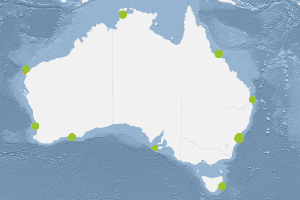Topic
biota
323 record(s)
Type of resources
Topics
Keywords
Contact for the resource
Provided by
Years
Formats
Representation types
Update frequencies
Status
draft
-
This dataset contains data collected by the Australian Continuous Plankton Recorder (AusCPR) survey and is funded by IMOS (Ships of Opportunity sub-facility) and CSIRO. The aims of the AusCPR survey are to: * map plankton biodiversity and distribution * develop the first long-term plankton baseline for Australian waters * document plankton changes in response to climate change * provide indices for fisheries management * detect harmful algal blooms * validate satellite remote sensing * initialise and test ecosystem models. The survey conducts repeat tows in the GBR, the East Australian Current and down to the Southern Ocean Time Series Mooring (SOTS). Other routes are conducted on an adhoc nature around Australia. The dataset also contains phytoplankton data from the UTAS / AAD led Southern Ocean CPR (SOCPR) project which is also funded by IMOS. The datasets available in this collection include Phytoplankton Colour Index (an estimate of chlorophyll in the water), phytoplankton abundance, zooplankton abundance and a biomass index from AusCPR and phytoplankton abundance from SOCPR. This data are freely available through the AODN portal: https://portal.aodn.org.au. This data is freely available but please acknowledge all relevant parties, as detailed in acknowledgement section.
-

This dataset comprises the phytoplankton abundance and biovolume estimates as part of a broader sampling program carried out at the Southern Ocean Time Series, a facility within the Integrated Marine Observing System (IMOS). The primary focus is sustained observing of ocean properties and processes important to climate, carbon cycling, and ocean productivity. Regular phytoplankton samples are collected at approximately 14 day intervals (exact intervals and seasonal coverage dependent on deployment length). The moorings are serviced annually, at which time the existing moorings are recovered and new moorings are deployed. Water samples from within the surface mixed-layer are collected at pre-programmed intervals using a Remote Access Sampler, in pairs about 1 hour apart. One sample in each pair is preserved for phytoplankton community composition by microscopy, and the other sample is preserved and used for accompanying chemical analysis of nutrients, total dissolved inorganic carbon (DIC) and alkalinity. Each sample is collected from within the surface mixed-layer at 32 m depth (2010 - 2017) or 5 m depth (2018-current) depending on the design of the mooring surface assembly and instrumentation. Typically a maximum of 24 samples are collected over an annual deployment cycle. The samples collected are analysed for: 1. Community composition / abundance (cells/L) 2. calculated biovolume (um3/L). Protocols for the phytoplankton time-series are described in Eriksen et al (2018), and the annual sample reports for each deployment. Data storage and access is planned to be interoperable with other national and international programs through the IMOS Infrastructure. Station metadata can be found through this resource. Data is available freely via the AODN portal: https://portal.aodn.org.au. As the taxonomic resolution of the data has changed over time, due to continual training, it is important that users refer to the change log tables included in your data download. These will provide information on the validity of the taxa, from what date we have been identifying certain taxa etc. Classification fields may be blank depending on the level to which that taxa has been identified, i.e. if only identified to family, genus and species will be blank.
-
Dugong and turtle catch data, turtle sighting and laparoscope data stored for 220 individuals on Fox pro database
-
Exploratory survey of Orange Roughy by the FV San Rankino south of Tasmania in 1992. This ship fished for Orange Roughy to support Southern Surveyor SS9201. The data includes station logs and catch composition.
-
This record contains fisheries statistics, History of Marine Animal Populations, trawling, overfishing from the Australian fishing industry between 1951 and 1957.
-
Live coral cover of reefs in the Torres Strait Generated as a layer to use in the eAtlas web-portal, as a base map layer.
-
This record contains fisheries statistics, History of Marine Animal Populations, trawling, overfishing from the Australian fishing industry between 1918 and 1923.
-
This record contains fisheries statistics, History of Marine Animal Populations, trawling, overfishing from the Australian fishing industry between 1937 and 1943.
-
NSW Fisheries demersal fish and prawn surveys from 1975 to 2006 using the FRV Kapala (1990-96), FV Trader Horn, FV Shelley H, FV Kirrawa and FV May Bell II. Area of operations is from SW Queensland to Bass Strait. The CMAR Catch Operations data set includes information about the time, location depth and catch method (trawl net etc) for each operation, species code and specimen details. Individual metadata records have been created for each research voyage. The data are held in the CMAR Data Warehouse, which currently holds over 4165 (hauls) catch operation records.
-
This record describes the datasets collected from the development of a Gene Tagging Tool for the Regional Tuna Tagging Programme (RTTP) which is managed under the auspices of the Indian Ocean Tuna Commission and genetic tagging studies. The aim is to quantify population structures and migratory dynamics which are currently poorly understood. The use of SNP markers lend themselves easily to routine and inexpensive ($10-$20 per fish) screening methodologies. The stock assessment advice is used to assist in the conservation and optimal economic use of this resource. This record describes the datasets collected or resulting from the outcome of the programme. Acronyms: ANSFAS: -Australia New Zealand Food Authority SNPs: -Single Nucleotide Polymorphisms IOTC: -Indian Ocean Tuna Commission RTTP: -Regional Tuna Tagging Programme FRDC: -Fisheries Research and Development Corporation
